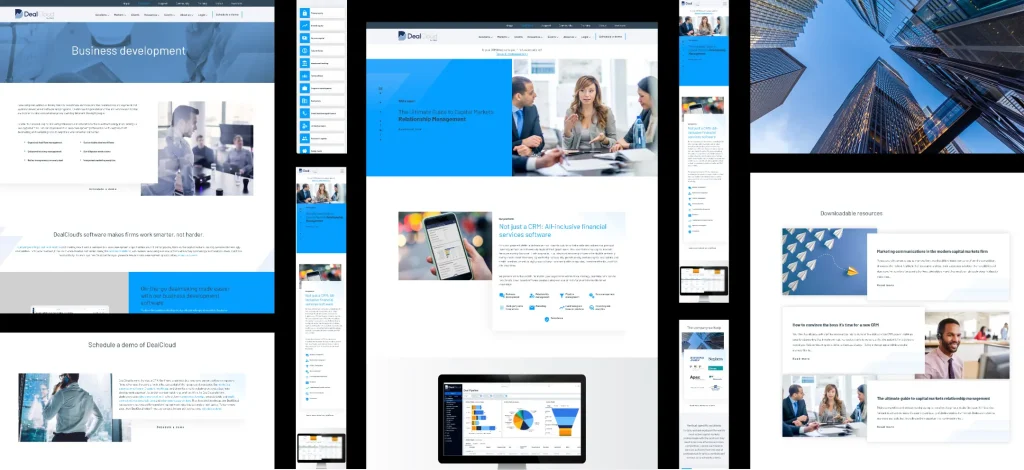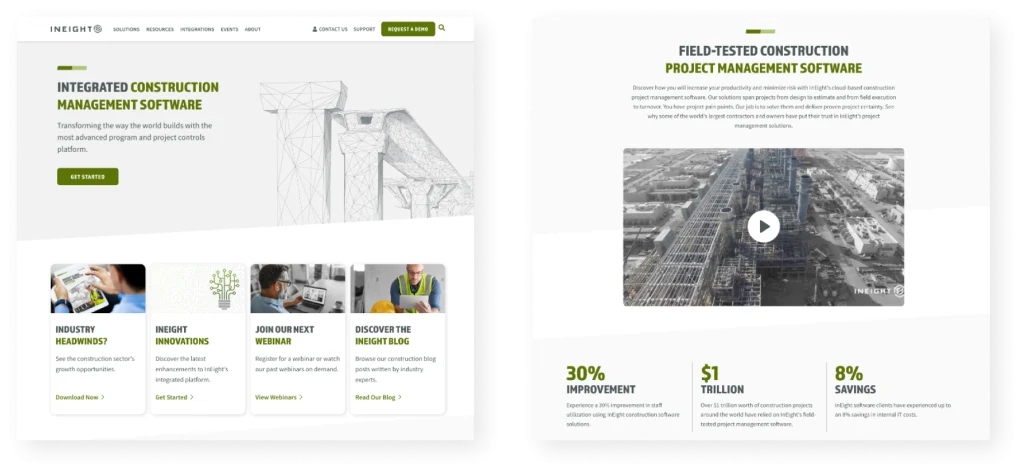In this post, we discuss how to prepare your website launch marketing plan, including what tools you’ll need to track success, social media announcements, and how to prepare your SEO and marketing campaigns for your launch.
Launching a new website is a huge accomplishment. You’ve likely spent the last several weeks or months working on it and coordinating with stakeholders at your organization to make sure that the website will serve everyone’s individual needs. As you get closer and closer to the launch of the website, the focus starts to turn to what needs to happen after the website is live.
The goal of reinventing your website is to reach more clients than before and show your brand’s innovation. It isn’t simply launching your website and calling it a day. You also need a comprehensive marketing plan surrounding your website’s reveal to generate attention after the launch.
As a marketer, your role through the website launch typically involves you wearing many hats. Wrangling your team’s needs and compiling them into simple and executable marketing initiatives can be a stressful process. We aim to make your role easier by creating this website launch marketing checklist. Our hope is that the checklist is a good starting point in the marketing campaign for your company.
The checklist goes through SEO tips for your content, as well as social media announcements and PR. You will want to go through this checklist at the start of the website design process (a couple months before launch), in order to give yourself enough time to achieve the marketing objectives listed below.

The Importance of a Website Launch Marketing Plan
Launching your website without a marketing plan in place is like ordering a Pumpkin Spice Latte from Starbucks and not sharing it on your social media. Did you even get the drink if you don’t share about it? All jokes aside, a marketing strategy for post launch will help you get the absolute most value from your investment in a new website.
Investing time and money into a new website is good for your business, but it’s only half the strategy. The other half is to create awareness and gain leads using your new publishing platform (your website). No matter how beautifully designed and thought out your website is, it won’t matter if it’s not getting any visibility. The importance of a marketing plan post a new website launch is substantial and encompasses several critical aspects:
- Sustained Visibility and Engagement: After the initial launch buzz subsides, a structured marketing plan ensures your website’s continued visibility. Consistent marketing efforts keep your brand fresh in the minds of your audience, encouraging repeated visits and engagement.
- Audience Reach and Growth: A well-executed marketing plan helps expand your website’s reach to a wider audience. By targeting different demographics through various channels, you can attract new visitors, potentially turning them into loyal customers.
- Showcasing Innovation: A new website often embodies your brand’s latest innovations and offerings. A post-launch marketing plan allows you to highlight these innovations to a larger audience, reinforcing your brand’s reputation for staying ahead in your industry.
- Conversion Optimization: A marketing plan doesn’t stop at attracting visitors; it aims to convert them into leads or customers. Post-launch marketing efforts can include strategies to optimize conversion rates, such as targeted content, personalized offers, and compelling calls-to-action.
- Building Brand Authority: Consistent marketing activities post-launch position your brand as an authority in your field. Valuable content, thought leadership, and engaging interactions help establish your website as a go-to resource, fostering trust among your audience.
- Staying Ahead of Competition: In today’s competitive landscape, maintaining a strong online presence is vital. A post-launch marketing plan enables you to remain competitive by adapting to changing trends, technologies, and user preferences.
- Long-Term Growth: Building a successful online presence is not a one-time event; it’s an ongoing process. A structured marketing plan contributes to the long-term growth of your website’s traffic, engagement, and conversions.
- Maximizing ROI: A well-planned marketing strategy ensures that your investment in the website launch continues to yield returns over time. By attracting and retaining customers, you maximize the return on your initial investment.
Website Launch Marketing Plan
A marketing plan post new website launch is a roadmap to sustained success. It helps you maintain momentum, attract a growing audience, and achieve your business objectives in the ever-evolving digital landscape. Here are a few aspects to prepare for to ensure your marketing efforts are a success:
Set Up Website Analytics
Installing the right analytics tools on your website post-launch is crucial for tracking its performance, understanding user behavior, and making informed decisions for optimization. It’s not uncommon to see significant changes to your traffic after launching a new website so you will want to make sure that you have a good baseline to measure against. Here are some essential analytics tools and metrics you should consider:
- Google Analytics: This is a fundamental tool for tracking website traffic, user behavior, and engagement. It provides insights into the number of visitors, pageviews, bounce rates, average session duration, and more. It also offers detailed demographic and geographic information about your audience.
- Google Search Console: Search Console helps you monitor your website’s presence in Google’s search results. It provides data about search performance, indexing status, and any issues affecting your website’s visibility in search results.
- Conversion Tracking: Set up conversion tracking to measure specific actions users take on your website, such as form submissions, purchases, or downloads. This helps you understand how effectively your website is driving desired actions.
- Heatmaps and User Session Recording Tools: Tools like Crazy Egg or Hotjar offer heatmaps that visually display where users are clicking and interacting the most on your website. User session recording provides actual video recordings of user interactions, helping you identify usability issues and areas for improvement.
- SEMrush: SEMrush allows your to track your position on certain keywords you are wanting to rank for. You can track your progress over time as well as analyze other keywords your competitors may be ranking for. This tool is a must-have when it comes to your SEO growth strategy.
Begin Tracking Events and Goals
Tracking events and goals on your website post-launch involves setting up analytics tools to monitor specific user interactions and actions. Here’s a general process you can follow to track events and goals effectively:
- Define Your Goals and Events: Start by identifying the key actions you want users to take on your website. These are your goals and events. Examples include form submissions, button clicks, downloads, video views, and purchases. Determine the value of each goal or event in terms of their impact on your business objectives.
- Choose the Right Analytics Platform: If you’re using Google Analytics, set up goals and events within your Google Analytics account. Other analytics platforms will have similar features but might be structured differently.
- Set Up Goals in Google Analytics: Log in to your Google Analytics account and navigate to the property for the website you want to track. In the Admin section, under the View column, click on “Goals.” Click the “+ New Goal” button to create a new goal. Choose the goal type based on the action you want to track (e.g., Destination, Duration, Pages/Screens per session, Event). Configure the goal details based on the goal type. For example, if you’re tracking an event, select the “Event” option and set the event conditions.
- Set Up Event Tracking: If you’re tracking specific interactions like button clicks, video plays, or downloads, you need to implement event tracking code on your website. For Google Analytics, use the ga(‘send’, ‘event’, …) function to trigger events. The syntax includes category, action, label, and value parameters.
- Test and Verify: After implementing event tracking, test it to ensure events are being recorded accurately. You can use browser developer tools or analytics debugging tools to check if events are being sent correctly.
- Monitor Analytics Data: Give the analytics tools some time to collect data. Regularly check your analytics platform to see how your goals and events are performing. Analyze the data to gain insights into user behavior, conversion rates, and the effectiveness of your website in achieving its objectives.
- Optimize and Refine: Use the insights from your analytics data to optimize your website. Identify areas where users might be dropping off or not engaging as expected, and make improvements accordingly.
- Iterate and Improve: Continuously monitor and analyze your analytics data. Use A/B testing and experimentation to improve your website’s performance and conversion rates over time.
Plan Your Content for SEO
The goal of SEO for your business is to create organic traffic to your site from the search engine results. Why is that important? 51% of shoppers use Google to research a purchase they intend to make online. Half of our population is searching keywords that will lead them to a purchasing decision. It is crucial your website is ready for those keywords searches pertaining to your business. Preparing your SEO (Search Engine Optimization) for a website launch is crucial to ensure that your new website gets off to a strong start in terms of search engine visibility and rankings. Here’s a step-by-step guide to help you prepare your SEO for a website launch:
- Keyword Research and Strategy: Conduct thorough keyword research to identify the relevant keywords and phrases your target audience is searching for. Create a list of primary and secondary keywords that align with your content and offerings. During the weeks where you are creating content for your website, research what keywords are going to lead to more business and implement those into your new content.
Review Google Search Console to see what keywords are currently working on your old website and work those into the content to prevent tanking existing SEO. Are targeted keywords included on your most visited pages? If you are using keywords through your website, you want the keyword to take them to the pertaining page. - Optimize On-Page Elements: Ensure that your website’s title tags, meta descriptions, headers, and content include your target keywords naturally and effectively. Create SEO-friendly URLs that are concise, descriptive, and include relevant keywords.
- Create High-Quality Content: Develop high-quality, relevant, and engaging content that addresses the needs and interests of your target audience. Incorporate your target keywords naturally within the content, headings, and subheadings.
- Set Up Proper URL Redirects: If your new website involves changes in URL structure, set up 301 redirects from old URLs to their corresponding new URLs. This preserves your existing SEO value and ensures a seamless user experience.
- Optimize Images and Media: Compress images for faster loading times without compromising quality. Use descriptive file names and alt text for images to make them accessible to search engines.
- Ensure Mobile Responsiveness: Optimize your website’s design and functionality for mobile devices. Mobile-friendliness is a significant ranking factor for search engines.
- Submit XML Sitemap: Create an XML sitemap that lists all the pages on your website. Submit this sitemap to Google Search Console and other search engines to help them index your pages effectively.
Ensure Your Code Is Top-Notch
- Verify that the meta descriptions and meta titles are set on each page. An easy way to check meta tags is by using the Facebook Share Debugger.
- Are headings appropriately used through each page? Headings are used by search engines to rank websites, so you should use your headings as another opportunity to utilize keywords.
- Check to see if all redirects from old pages are going to the correct pages on the new site. Broken links are not great for SEO, because the search engine will assume that page is gone and you will no longer receive the SEO value of the page with a different link.
- Pages and editorial content links to internal pages where appropriate
- Schema markup is added to pages to help them show up in Google rich search results
SEM
Search engine marketing (SEM) is the practice of using paid advertisements on search engine results pages to generate more traffic to your website. If you are new to SEO and want results quicker than months away, using SEM is a great strategy for your business. Both SEO and SEM are centered around keywords, but SEM is the process of putting your business in higher rankings for specific keywords.
- Define Your Objectives: Clearly outline your goals for the SEM campaign. Are you aiming for brand awareness, website traffic, lead generation, or conversions?
- Keyword Research: Conduct thorough keyword research to identify the most relevant and high-performing keywords related to your business, products, or services.
- Set Up Google Ads Account: If you’re using Google Ads (formerly Google AdWords), create an account and set up relevant campaigns based on your objectives.
- Campaign Structure: Organize your campaigns into ad groups based on specific themes or keyword groups. This helps you create more targeted ads and landing pages.
- Create Compelling Ad Copy: Write persuasive ad copy that highlights your unique selling points and encourages clicks. Use keywords naturally in your ad headlines and descriptions.
Set Up Paid Campaigns
Create a schedule and budget for your campaign to run at least the first couple months after your launch. SEM will bring an immediate presence to your website, but once your SEO gains traction, you can lower your monthly ad spend.
Start by defining clear campaign objectives, whether it’s driving traffic, generating leads, or increasing conversions. Conduct thorough keyword research to identify relevant and high-performing keywords. Create compelling ad copy that highlights your unique value proposition and resonates with your target audience.
Develop optimized landing pages that provide a seamless user experience and align with your ad messaging. You can also send page visitors directly to your homepage if landing pages are not an option. Set up conversion tracking to measure key actions and outcomes. Choose the right bidding strategy and allocate your budget effectively across campaigns and ad groups.
Continuously monitor and analyze campaign performance, making data-driven optimizations to ensure maximum impact and success during your website’s launch phase.
Get Social Media Ready
Preparing social media for a new website launch involves a strategic approach to maximize its impact. Begin by crafting a comprehensive social media plan that outlines your goals, target audience, messaging, and posting schedule.
Develop engaging and visually appealing content that highlights the key features, benefits, and innovations of your new website.
Coordinate with your team to create a content calendar that builds anticipation leading up to the launch. Utilize a mix of posts, including teasers, behind-the-scenes glimpses, countdowns, and interactive content to foster engagement. Leverage relevant hashtags and collaborate with influencers or partners to extend your reach.
Finally, schedule your posts strategically, monitor interactions, and be prepared to respond promptly to comments and messages, ensuring a seamless and exciting social media presence for your new website’s launch.
A few more social media tips:
- Pre-write any copy surrounding the launch, so it’s a quick copy-and-paste to the perspective profiles.
- Look into which social media platforms perform the best for engagement and what types of posts are receiving the most attention. Use these platforms and create more specific content that fits the platform (ex. If LinkedIn performs the best, create a social campaign for LinkedIn, posting several times before the launch).
- Share any animated or live action videos surrounding the website launch. These could include: explainer videos, message from the CEO, or a video announcing a new product/service launch.
Prepare Press Releases
After months of preparation, it’s time to share the news with everyone. In the press release, you can share about all the new features on your website and how the website will be a useful tool for your company and others who visit it. Press releases are the place to brag about your website and encourage users to explore it.
Preparing a press release for a new website launch requires a structured approach to effectively communicate your key messages to the media and your target audience. Here’s a step-by-step guide:
- Start with a Strong Headline: Craft a concise and attention-grabbing headline that captures the essence of your new website and its significance.
- Write a Compelling Lead Paragraph: The first paragraph should summarize the most important information: who, what, when, where, and why. Provide a brief overview of your company and the purpose of the new website.
- Provide Detailed Information: In subsequent paragraphs, elaborate on the features, benefits, and innovations of the website. Explain how it addresses a need or solves a problem for your target audience.
- Include Quotes: Include quotes from key stakeholders, such as company leaders or project managers. These quotes add a human touch and provide insight into the motivation behind the website launch.
- Highlight Key Points: Use bullet points or subheadings to highlight key features, functionalities, and any unique aspects of the website.
- Include Visuals: Attach high-quality images, screenshots, or logos that showcase the website’s design and user interface.
Work With Us
We have seen huge success from companies who invest not only in their new website, but also their marketing campaign to go with it. There’s a lot to be said about preparation in an investment like this. Creating a beautiful website is only half the process. We hope this checklist helps shed some light on what items you can prepare for in your website marketing launch.
If you are interested in creating a new website, launching a new marketing campaign, or learning more about what we do, please check out our approach page. We have laid out all the information you will need to determine if we are the right agency for you. Schedule a consultation with us today.





